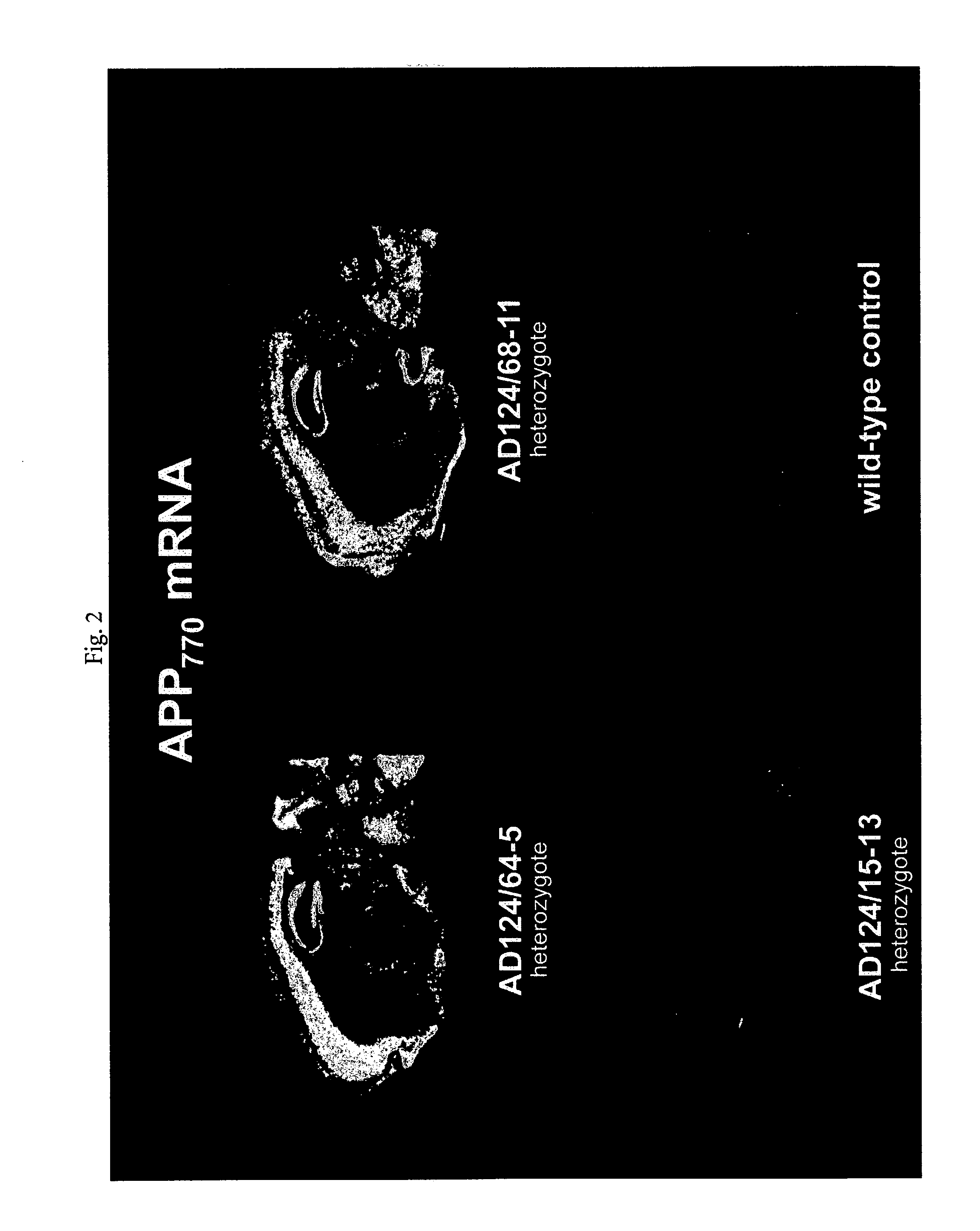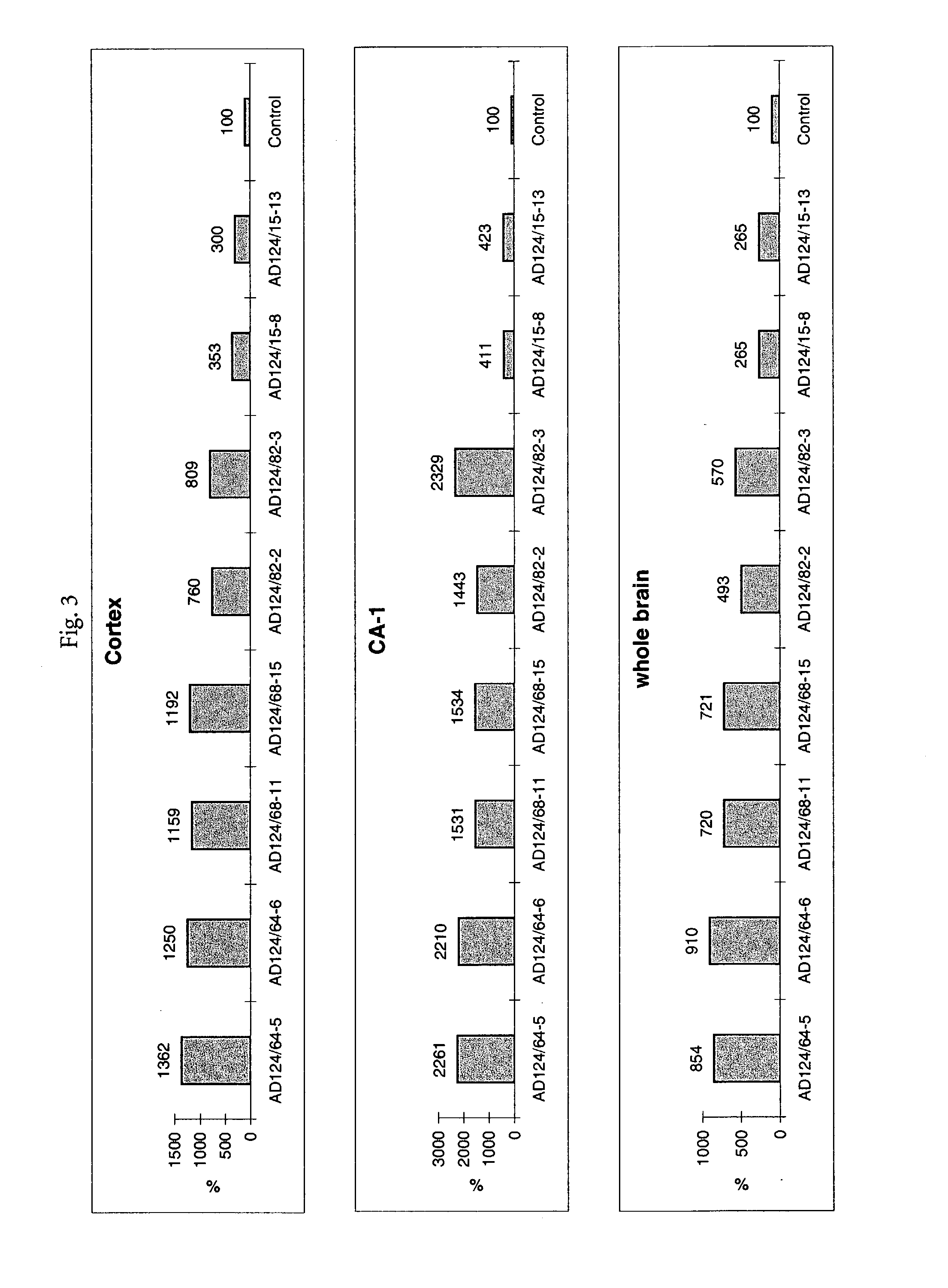Double transgenic mice overexpressing human beta secretase and human APP-London
a technology of human beta secretase and double transgenic mice, which is applied in the direction of viruses/bacteriophages, instruments, drug compositions, etc., can solve the problem that current treatments for ad provide only modest symptomatic reli
- Summary
- Abstract
- Description
- Claims
- Application Information
AI Technical Summary
Benefits of technology
Problems solved by technology
Method used
Image
Examples
example 1
APPV717F Transgenic Mice
[0101] Transgenic mouse lines express human APP with the London mutation (V717F) under the control of the mouse Thy1 promoter (Malherbe P, Richards J. G, Bluethmann H, Martin J. R, Bleuel Z, Thomas, B, Fischer C, Diener C and Huber G. Transgenic mice overexpressing three isoforms of human mutant amyloid precursor protein driven by the neuron-specific elements of the thy-1 gene promoter. Soc. Neurosci., 1997. Abstr.23, 1636). These mouse lines were denominated AD124.
[0102] A. Generation of the Human APP London Vector Contruct
[0103] The London familial AD mutation (FAD, V717F substitution) was introduced in human .beta.APP.sub.695 cDNA by site-directed mutagenesis as described previously (Malherbe P, Richards J G, Martin J R, Bluethmann H, Maggio J, Huber G. Lack of beta-amyloidosis in transgenic mice expressing low levels of familial Alzheimer's disease missense mutations. Neurobiol Aging. 1996. 17:205-14). By site directed mutagenesis (SDM), a BamH1 site was ...
example 2
BACE Transgenic Mice
[0115] Transgenic mouse lines express human BACE protein under the control of the mouse prion promoter. These mouse lines were denominated Prp-Asp.
[0116] A. Generation of the Human BACE Vector Contruct
[0117] The BACE 1 cDNA (SEQ ID NO:8) encoding protein sequence of SEQ ID NO:9 and comprising the complete open reading frame (ORF) plus flanking restriction sites was inserted into a mouse prion minigene vector where the prion ORF had been replaced by a suitable unique cloning site. The original minigene construct pPrPHg was described by Fischer et al. (Fischer M, Rulicke T, Raeber A, Sailer A, Moser M, Oesch B, Brandner S, Aguzzi A, Weissmann C. Prion protein (PrP) with amino-proximal deletions restoring susceptibility of PrP knockout mice to scrapie. EMBO J. 1996. 15:1255-64). In brief, the mouse prion ORF between an upstream KpnI site and a downstream NarI site was removed and replaced by a SceI restriction site. The BACE1 containing fragment was inserted by blun...
example 3
BACE and APP London Double Transgenic Mice
[0136] A. Crossbreeding of AD124 Transgenic Mice Overexpressing Human APPV717F with Prp-Asp Transgenic Mice Overexpressing Human BACE
[0137] Following standard crossbreeding protocols (male / female ratio of 1:1 or 1:2), APPV717F high expressor transgenic line AD124 / 68 was crossed with BACE high expressor transgenic lines Prp-Asp13 or Prp-Asp24. The first type of crossbreeding involved homozygotic APPV717F mice and heterozygotic Prp-Asp transgenic mice leading to bigenic littermates (APPV717+ / - and BACE+ / -) and singly transgenic littermates (APPV717+ / -). The second type of crossbreeding involved heterozygotic APPV717F transgenic mice and heterozygotic Prp-Asp transgenic mice resulting in the generation of non-transgenic littermates (APPV717- / - and BACE- / -), bigenic littermates (APPV717+ / - and BACE+ / -), singly transgenic littermates (APPV717+ / -), and singly transgenic littermates (BACE+ / -). Mouse genotype was confirmed using PCR with tail DNA.
[0...
PUM
| Property | Measurement | Unit |
|---|---|---|
| Mass | aaaaa | aaaaa |
| Mass | aaaaa | aaaaa |
| Mass | aaaaa | aaaaa |
Abstract
Description
Claims
Application Information
 Login to View More
Login to View More - R&D
- Intellectual Property
- Life Sciences
- Materials
- Tech Scout
- Unparalleled Data Quality
- Higher Quality Content
- 60% Fewer Hallucinations
Browse by: Latest US Patents, China's latest patents, Technical Efficacy Thesaurus, Application Domain, Technology Topic, Popular Technical Reports.
© 2025 PatSnap. All rights reserved.Legal|Privacy policy|Modern Slavery Act Transparency Statement|Sitemap|About US| Contact US: help@patsnap.com



